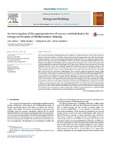An investigation of the appropriateness of current methodologies for energy certification of Mediterranean housing
| dc.contributor.author | Abela, A | |
| dc.contributor.author | Hoxley, M | |
| dc.contributor.author | McGrath, P | |
| dc.contributor.author | Goodhew, Steve | |
| dc.date.accessioned | 2016-10-25T07:44:24Z | |
| dc.date.issued | 2016-10-15 | |
| dc.identifier.issn | 0378-7788 | |
| dc.identifier.issn | 1872-6178 | |
| dc.identifier.uri | http://hdl.handle.net/10026.1/6614 | |
| dc.description.abstract |
The Energy Performance of Buildings Directives (EPBDs) are political initiatives taken by the European Union to tackle the problems of climate change and security of energy supply. One of the key measures of these directives is the use of Energy Performance Certificates (EPCs) to model the energy performance of housing. This research investigates whether the current calculation methodologies in use for the generation of EPCs in the Mediterranean are appropriate. The analysis was carried out by comparative testing using different national methodologies from Cyprus, Italy, Malta and Spain on four test case study dwellings. The test results were validated against the output from dynamic simulation software and against monitored temperature and energy data from the test case properties. Considerable differences in the outputs from the various national methodologies currently in use were found. It was concluded that several of the EPC calculation methodologies have not been calibrated against the energy profile representative of the national or regional building stock; accurate definition of the operating parameters for the heating and cooling system is particularly significant if a more precise prediction of the energy performance of the dwelling is required; and the underlying assumptions made by the national application of the EN ISO 13790 standard for the calculation of the energy use for space heating and cooling have a greater influence on the outputs from the certification methodology than the choice of calculation method. It is quite clear that calibration of the EPC methodology is essential for the certificates to provide an effective means of achieving the aims of the EPBD. However, at a conceptual level, the results from this research have also shown that the mild Mediterranean climate with its inherently low energy demand for residential space heating and cooling could justify a different regional approach to tackle the EPBD goals of reduction in carbon emissions and dependency on imported fuels. | |
| dc.format.extent | 210-218 | |
| dc.language | en | |
| dc.language.iso | en | |
| dc.publisher | Elsevier BV | |
| dc.subject | Energy certification | |
| dc.subject | Mediterranean region | |
| dc.subject | Dwellings | |
| dc.subject | Methodologies | |
| dc.title | An investigation of the appropriateness of current methodologies for energy certification of Mediterranean housing | |
| dc.type | journal-article | |
| dc.type | Journal Article | |
| plymouth.author-url | https://www.webofscience.com/api/gateway?GWVersion=2&SrcApp=PARTNER_APP&SrcAuth=LinksAMR&KeyUT=WOS:000385323900020&DestLinkType=FullRecord&DestApp=ALL_WOS&UsrCustomerID=11bb513d99f797142bcfeffcc58ea008 | |
| plymouth.volume | 130 | |
| plymouth.publication-status | Published | |
| plymouth.journal | Energy and Buildings | |
| dc.identifier.doi | 10.1016/j.enbuild.2016.07.056 | |
| plymouth.organisational-group | /Plymouth | |
| plymouth.organisational-group | /Plymouth/Faculty of Arts, Humanities and Business | |
| plymouth.organisational-group | /Plymouth/Faculty of Arts, Humanities and Business/School of Art, Design and Architecture | |
| plymouth.organisational-group | /Plymouth/REF 2021 Researchers by UoA | |
| plymouth.organisational-group | /Plymouth/REF 2021 Researchers by UoA/UoA13 Architecture, Built Environment and Planning | |
| plymouth.organisational-group | /Plymouth/Users by role | |
| plymouth.organisational-group | /Plymouth/Users by role/Academics | |
| dcterms.dateAccepted | 2016-07-25 | |
| dc.rights.embargodate | 2017-8-20 | |
| dc.identifier.eissn | 1872-6178 | |
| dc.rights.embargoperiod | Not known | |
| rioxxterms.versionofrecord | 10.1016/j.enbuild.2016.07.056 | |
| rioxxterms.licenseref.uri | http://www.rioxx.net/licenses/all-rights-reserved | |
| rioxxterms.licenseref.startdate | 2016-10-15 | |
| rioxxterms.type | Journal Article/Review |


